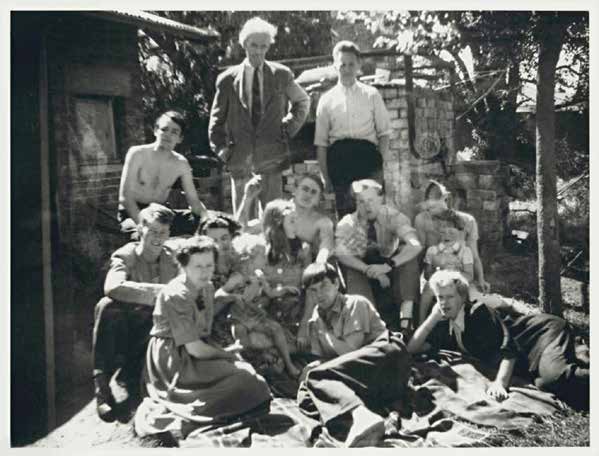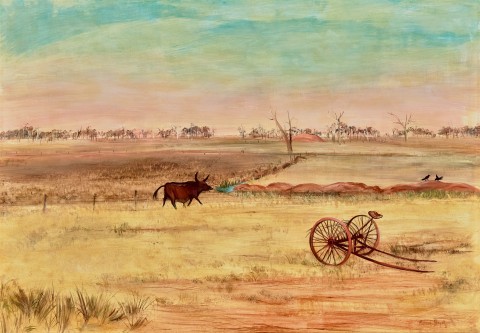SANTA GERTRUDIS BULL, 1950
ARTHUR BOYD
oil and tempera on composition board
83.5 x 122.0 cm
signed lower right: Arthur Boyd
extensively inscribed and partly struck through verso:
(inverted) JOHN MARTIN / 100 RUNDLE ST / ADELAIDE / AG-49 SYDNEY / ROOF
SANTA / GERTRUDIS BULL
ROBIN BOYD / 290 WALSH ST, / SOUTH YARRA / £500
ROBIN BOYD / 158 RIVERSDALE / ROAD /CAMBERWELL
DAVID JONES / ART / GALLERY / DAVID JONES / ELIZABETH ST / SYDNEY
Martin Boyd, Melbourne, a gift from the artist, early 1950s
Robin Boyd, Melbourne, acquired from the above, late 1950s
Thence by descent
Patricia Boyd, Melbourne, 1971
Estate of Patricia Davies (formerly Mrs Robin Boyd), Melbourne
Thence by descent
Private collection, Canberra
possibly: Arthur Boyd Retrospective Exhibition, David Jones Gallery, Sydney, 4 – 16 September 1950, cat. 10
Arthur Boyd, Peter Bray Gallery, Melbourne, 15 – 24 September 1953, cat. 32 (as ‘The Santa Gertrudis Bull’)
Arthur Boyd Retrospective, Whitechapel Gallery, London, June – July 1962, cat. 43, p. 25
Philipp, F., Arthur Boyd, Thames and Hudson, London, 1967, cat. 5.42, p. 247 (dated ‘1950 – 51’)
Hoff, U., The Art of Arthur Boyd, Andre Deutsch, London, 1986, p. 48
Irrigation Lake, Wimmera, 1950, resin and tempera on composition board, 81.4 × 121.9 cm, in the collection of the National Gallery of Victoria, Melbourne
NOVL21 Cat proof 7_10_2021 B (2) (002)3.jpg

‘…This type of landscape – flat fields or paddocks, the ‘motif of intimacy’ reduced to a haystack, shed or stand of dry thistles or a piece of farming equipment, a few scattered trees in the middle-ground with the closing horizontal of a low distant hill – can be encountered in most of the non-alpine interior of south-eastern Australia, though it is most typical of the plain wheat country of central western Victoria – the Wimmera… Here art met nature – the ‘formula’, the vocabulary, fully fitted the ‘content’ of this dry, semi-arid sheep and wheat country, turning yellow and sun-parched in summer, with patches of burnt off stubble or weed, the grass often eaten down to bareness where the stand of hard dry thistles acquires the accentuation of bushes.’1
An untiring and extremely skilful painter of landscapes, Arthur Boyd is undoubtedly one of Australia’s most revered and admired artists whose highly personalised paintings of his homeland have become iconic within the national consciousness. Among the more revelatory and widely acclaimed of his achievements, the extended sequence of luminous, sun-parched landscapes inspired by his travels to the Wimmera region in north-west Victoria and encapsulated here by the magnificent Santa Gertrudis Bull, 1950, are particularly celebrated. As Janet McKenzie elaborates, ‘…[in these paintings] Boyd created an archetypal Australian landscape. Possessing both a poetic lyricism and a down to earth quality and capturing the glorious light, these works… [offer] a sense of acceptance that many country-dwelling Australians could identify with.’2
Boyd first encountered the Wimmera region during the summer of 1948 – 49 when he accompanied the poet Jack Stevenson on a number of expeditions to Horsham in north-west Victoria. With its flat, semi-arid paddocks and endless horizons, the wheat-farming district presented Boyd with such a stark contrast to the verdant, undulating hills of Berwick and Harkaway (where he had recently undertaken an expansive mural series of Brughelesque idylls at his uncle’s property, The Grange) that he found himself required to develop a new visual vocabulary in order to capture this desolate landscape. Although the Wimmera could not be described as ‘uninhabitable’, it was for Boyd, his first glimpse of the vastness of Australia’s interior. As Barry Pearce notes, ‘…He discovered there a hint of something that had drawn other painters of his generation, a subject tentatively recorded by a few artists of the nineteenth century and touched on by even fewer of the twentieth: the empty spaces of the great interior. Of course, the Wimmera was wheat country and not by any means forbidding, nor forsaken. But in hot dry weather it could have, over sparse, unbroken horizons, a searing expanse of sky that elicited an acute sense of the infinite…’3
When initially unveiled at the David Jones Gallery in 1950, the Wimmera landscapes such as the present were greeted with universal acclaim – no doubt, as more than one author has observed, ‘because their sun-parched colours were so reminiscent of the Heidelberg school.’4 Significantly the paintings resonated not only amongst the public, but also with institutions such as the National Gallery of Victoria who purchased arguably the most famous work from the series, Irrigation Lake, Wimmera, 1950, and the Art Gallery of New South Wales who acquired Midday, The Wimmera, 1948 – 49 – thereby representing the first works by Boyd to enter a major public collection. Encouraged by the critical success of the show, Boyd thus embarked upon further trips to the region, creating between 1948 and 1951, a body of work now referred to as the ‘first’ Wimmera landscapes. Imbued with the spirit of the land, these works represented for many their first encounter with these ‘more intimate aspects of the Australian landscape’5 and thus, not only established Boyd’s reputation as ‘an interpreter of the rural Australian environment’6, but moreover, launched his career on the international stage, with Boyd subsequently awarded the honour of representing Australia at the Venice Biennale in 1958.
An amalgam of visual observation, artistic experience and emotional response, Santa Gertrudis Bull illustrates well the complexity of Boyd’s Wimmera paintings. Although portraying the harsh reality of this desolate, sun-scorched landscape, Boyd does not endow the scene with the drama of the desert as both Russell Drysdale and Sidney Nolan had done previously. To the contrary, by including visible scars of human presence left on the land – a horse-drawn cultivator; the compacted mounds of earth denoting irrigation channels for farming; and of course, the magnificent black bull and ubiquitous crows – Boyd here creates an image of intimacy and warmth, enhanced by the rose-hued evening sky which infuses the entire composition with a sense of joyous optimism. Indeed, the work exudes a stillness and calm acceptance comparable to the mood discernible in his Mornington Peninsula landscapes: there is no angst, no challenge, no dramatic dialogue between man and nature as may be found elsewhere in Boyd’s oeuvre. Rather, as Franz Philipp astutely observes, in such Wimmera paintings ‘…the figures are small, submerged and humble, but they are inhabitants not pioneers. They are at home… the phrase ‘landscapes of love’ comes to mind.’7
So profound was the impact of the stark simplicity and shimmering light of the Wimmera upon Boyd’s psyche that he would revisit the subject on several occasions during the late 1960s and 1970s – whether painting at his property Riversdale on the Shoalhaven river in southern New South Wales, or abroad while residing in London. Although this second, subsequent series of Wimmera landscapes offered a sophisticated reappraisal of the theme with their absolute sparseness, economy of detail and restrained palette, it is the paintings of 1948 – 51 – exemplified superbly here by the present work – which, with their gritty realism and immediacy of vision, represented an important turning point in the history of Australian landscape painting.
1. Philipp, F., Arthur Boyd, Thames and Hudson, London, 1967, p. 62
2. McKenzie, J., Arthur Boyd: art and life, Thames and Hudson, London, 1967, p. 62
3. Pearce, B., Arthur Boyd Retrospective, The Art Gallery of New South Wales and The Beagle Press, Sydney, 1993, p. 20
4. Campbell, R., ‘Arthur Boyd (1920 – )’, Australia: Paintings by Arthur Streeton and Arthur Boyd, XXIX Biennale, Venice, 1958, n.p.
5. Pearce, op. cit., p. 20
6. Philipp, op. cit., p. 67
7. Ibid., p. 64
VERONICA ANGELATOS
